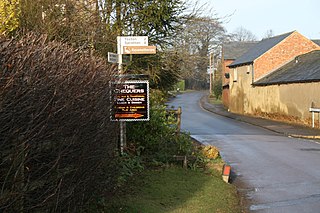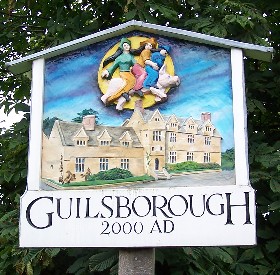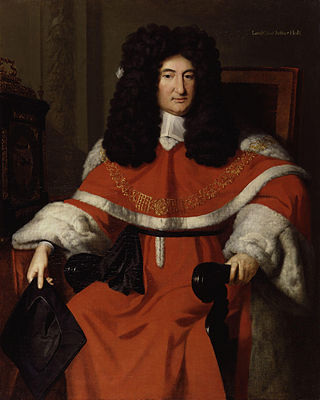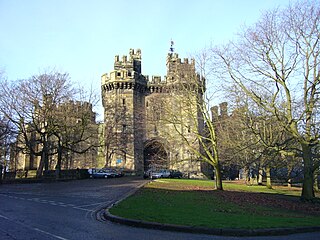
Matthew Hopkins was an English witch-hunter whose career flourished during the English Civil War. He was mainly active in East Anglia and claimed to hold the office of Witchfinder General, although that title was never bestowed by Parliament.
The Witchcraft Acts were a historical succession of governing laws in England, Scotland, Wales, Ireland, and the British colonies on penalties for the practice, or—in later years—rather for pretending to practice witchcraft.

Ravensthorpe is a village and civil parish in West Northamptonshire in England. The village lies approximately midway between Northampton and Rugby. The M1 motorway is six miles west and the nearest railway station is at Long Buckby. At the time of the 2001 census, the parish's population was 656 people, including Coton but falling slightly to 646 at the 2011 census.

Guilsborough is a village and civil parish in West Northamptonshire in England. At the time of the 2001 census, the parish's population was 882 people, reducing to 692 at the 2011 Census.

The North Berwick witch trials were the trials in 1590 of a number of people from East Lothian, Scotland, accused of witchcraft in the St Andrew's Auld Kirk in North Berwick on Halloween night. They ran for two years, and implicated over 70 people. These included Francis Stewart, 5th Earl of Bothwell, on charges of high treason.

Sir John Holt was an English lawyer who served as Lord Chief Justice of England from 17 April 1689 to his death. He is frequently credited with playing a major role in ending the prosecution of witches in English law.

Agnes Waterhouse, also known as Mother Waterhouse, was one of the first women executed for witchcraft in England.
The Witches of Warboys were Alice Samuel and her family, who were accused of, and executed for witchcraft between 1589 and 1593 in the village of Warboys, in the Fens of England. It was one of many witch trials in the early modern period, but scholar Barbara Rosen claims it "attracted probably more notice than any other in the sixteenth century".

Abington Park, in the Abington district of Northampton, Northamptonshire, England, has lakes, aviaries, and a museum, as well as trees and grassy open spaces.

The Bury St Edmunds witch trials were a series of trials conducted intermittently between the years 1599 and 1694 in the town of Bury St Edmunds in Suffolk, England.

The trials of the Pendle witches in 1612 are among the most famous witch trials in English history, and some of the best recorded of the 17th century. The twelve accused lived in the area surrounding Pendle Hill in Lancashire, and were charged with the murders of ten people by the use of witchcraft. All but two were tried at Lancaster Assizes on 18–19 August 1612, along with the Samlesbury witches and others, in a series of trials that have become known as the Lancashire witch trials. One was tried at York Assizes on 27 July 1612, and another died in prison. Of the eleven who went to trial – nine women and two men – ten were found guilty and executed by hanging; one was found not guilty.

The Samlesbury witches were three women from the Lancashire village of Samlesbury – Jane Southworth, Jennet Bierley, and Ellen Bierley – accused by a 14-year-old girl, Grace Sowerbutts, of practising witchcraft. Their trial at Lancaster Assizes in England on 19 August 1612 was one in a series of witch trials held there over two days, among the most infamous in English history. The trials were unusual for England at that time in two respects: Thomas Potts, the clerk to the court, published the proceedings in his The Wonderfull Discoverie of Witches in the Countie of Lancaster; and the number of the accused found guilty and hanged was unusually high, ten at Lancaster and another at York. All three of the Samlesbury women were acquitted.

Elizabeth Sawyer was a convicted witch during the reign of James I of England.
The Leicester boy trial was one of Leicester's most notorious witchcraft cases, in which a thirteen-year-old boy publicly accused 15 women of causing a possession within him. The case took place in Husbands Bosworth, a small village not far from Leicester in 1616. John Smith fell into a series of violent fits, not even several men could hold him down. He made strange noises, and, as noted in a letter from Alderman Robert Heyrick to his brother Sir William, he would beat himself with inhuman strength, yet somehow remain unharmed. He gave extensive details on their familiars. The two judges, Sir Humphrey Winch and Sir Ranulph Crewe quickly condemned the women, rounding all 15 of them up. Nine of them were tried, found guilty and hanged for allegedly possessing John Smith. The other six were placed in prison to wait their turn. None of them were named before being hanged. King James I happened to be passing through about a month later, and heard what was going on. He called for John Smith to be questioned, and had little trouble determining the child was fraudulent. He broke down, and confessed the truth. Of the six women who had been imprisoned, only five of them were released, as one of them died inside. According to a timeline, the woman who had died told the jailer she was working with the witches against Smith the day before she died. She had begged him not to say anything because the witches would harm her.
The witch trials in Connecticut, also sometimes referred to as the Hartford witch trials, occurred from 1647 to 1663. They were the first large-scale witch trials in the American colonies, predating the Salem Witch Trials by nearly thirty years. John M. Taylor lists a total of 37 cases, 11 of which resulted in executions. The execution of Alse Young of Windsor in the spring of 1647 was the beginning of the witch panic in the area, which would not come to an end until 1670 with the release of Katherine Harrison.

Elleine Smith was an English woman executed for witchcraft, and known from one of four surviving pamphlets detailing the so-called Essex Witches. The others mentioned were Elizabeth Frauncis, Margery Staunton and Alice Nokes.

The Windsor Witches was the common name for a witch trial in Windsor and Abingdon in England in 1579. The name referred to the four women tried and executed for sorcery: the cunning woman Mother Elizabeth Stile, Mother Devell, Mother Dutten and Mother Margaret.
Ann Foster was an English woman who was executed for witchcraft.
Cecily Manners, Countess of Rutland was an English aristocrat.













